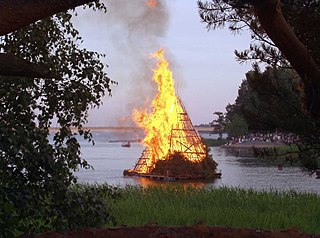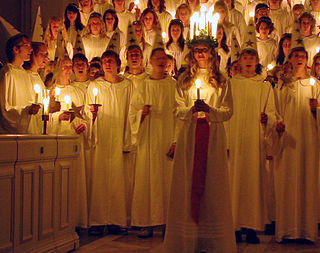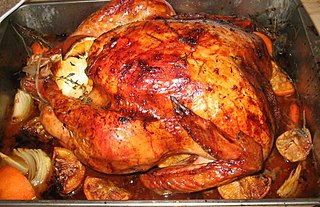
Halloween or Hallowe'en is a celebration observed in many countries on 31 October, the eve of the Western Christian feast of All Hallows' Day. It is at the beginning of the observance of Allhallowtide, the time in the liturgical year dedicated to remembering the dead, including saints (hallows), martyrs, and all the faithful departed. In popular culture, the day has become a celebration of horror, being associated with the macabre and supernatural.

May Day is a European festival of ancient origins marking the beginning of summer, usually celebrated on 1 May, around halfway between the spring equinox and summer solstice. Festivities may also be held the night before, known as May Eve. Traditions often include gathering wildflowers and green branches, weaving floral garlands, crowning a May Queen, and setting up a Maypole, May Tree or May Bush, around which people dance. Bonfires are also part of the festival in some regions. Regional varieties and related traditions include Walpurgis Night in central and northern Europe, the Gaelic festival Beltane, the Welsh festival Calan Mai, and May devotions to the Blessed Virgin Mary. It has also been associated with the ancient Roman festival Floralia.

Samhain, Sauin or Oíche Shamhna is a Gaelic festival on 1 November marking the end of the harvest season and beginning of winter or "darker half" of the year. It is also the Irish language name for November. Celebrations begin on the evening of 31 October, since the Celtic day began and ended at sunset. This is about halfway between the autumnal equinox and winter solstice. It is one of the four Gaelic seasonal festivals along with Imbolc, Bealtaine, and Lughnasa. Historically it was widely observed throughout Ireland, Scotland, and the Isle of Man. A similar festival is held by the Brittonic Celtic people, called Calan Gaeaf in Wales.

Michaelmas is a Christian festival observed in many Western Christian liturgical calendars on 29 September, and on 8 November in the Eastern Christian traditions. Michaelmas has been one of the four quarter days of the English and Irish financial, judicial, and academic year.

A bonfire is a large and controlled outdoor fire, used either for informal disposal of burnable waste material or as part of a celebration.

Walpurgis Night, an abbreviation of Saint Walpurgis Night, also known as Saint Walpurga's Eve, is the eve of the Christian feast day of Saint Walpurga, an 8th-century abbess in Francia, and is celebrated on the night of 30 April and the day of 1 May. This feast commemorates the canonization of Saint Walpurga and the movement of her relics to Eichstätt, both of which occurred on 1 May 870.

Midsummer is a celebration of the season of summer occurring at the summer solstice which is known in solar reckoning as the mid-point of the season. As the precise date of the summer solstice can vary from year to year, different traditions may celebrate or fix Midsummer at different dates or under different names occurring on or around the actual solstice. A variety of traditions have developed often rooted in regional, spiritual, or religious practices.

Mārtiņi or Mārtiņdiena is an ancient Latvian winter welcoming holiday, when the time of pieguļa and shepherding came to an end. According to a solar calendar, Mārtiņdiena marks the midpoint between the autumnal equinox (Miķeļi) and winter solstice (Ziemassvētki), and is celebrated in the middle of November. Mārtiņi ended Veļu laiks and started Ledus laiks, when the swamp became passable and raids of armed men sitting on horses were expected.

Saint John's Eve, starting at sunset on 23 June, is the eve of the feast day of Saint John the Baptist. This is one of the very few feast days marking a saint's birth, rather than their death. The Gospel of Luke states that John was born six months before Jesus; therefore, the feast of John the Baptist was fixed on 24 June, six months before Christmas. In the Roman calendar, 24 June was the date of the summer solstice, and Saint John's Eve is closely associated with Midsummer festivities in Europe. Traditions are similar to those of May Day and include bonfires, feasting, processions, church services, and gathering wild plants.
Scottish term and quarter days mark the four divisions of the legal year in Scotland. These were historically used as the days when contracts and leases would begin and end, servants would be hired or dismissed, and rent, interest on loans, and ministers' stipends would become due.

Saint Lucy's Day, also called the Feast of Saint Lucy, is a Christian feast day observed on 13 December. The observance commemorates Lucia of Syracuse, an early-fourth-century virgin martyr under the Diocletianic Persecution. According to legend, she brought food and aid to Christians hiding in the Roman catacombs, wearing a candle-lit wreath on her head to light her way, leaving both hands free to carry as much food as possible. Because her name means "light" and her feast day had at one time coincided with the shortest day of the year prior to calendar reforms, it is now widely celebrated as a festival of light. Falling within the Advent season, Saint Lucy's Day is viewed as a precursor of Christmastide, pointing to the arrival of the Light of Christ in the calendar on 25 December, Christmas Day.

The observance of Christmas around the world varies by country. The day of Christmas, and in some cases the day before and the day after, are recognized by many national governments and cultures worldwide, including in areas where Christianity is a minority religion. In some non-Christian areas, periods of former colonial rule introduced the celebration ; in others, Christian minorities or foreign cultural influences have led populations to observe the holiday.

Parkin is a gingerbread cake traditionally made with oatmeal and black treacle, which originated in Northern England. Often associated with Yorkshire, it is widespread and popular elsewhere, notably in Lancashire. Parkin is baked to a hard cake but with resting becomes moist and even sometimes sticky. There are regional differences, for example in Hull and East Yorkshire, it has a drier, more biscuit-like texture than in other areas whereas in Lancashire it is generally made with golden syrup rather than the treacle used elsewhere. Parkin is traditionally eaten on Guy Fawkes Night, 5 November, and when celebrating 'Yorkshire Day' on 1 August. But is also enjoyed throughout the winter months. It is baked commercially throughout Yorkshire, but is mainly a domestic product in other areas.

Christmas dinner is a meal traditionally eaten at Christmas. This meal can take place any time from the evening of Christmas Eve to the evening of Christmas Day itself. The meals are often particularly rich and substantial, in the tradition of the Christian feast day celebration, and form a significant part of gatherings held to celebrate the arrival of Christmastide. In many cases, there is a ritual element to the meal related to the religious celebration, such as the saying of grace.

Candlemas, also known as the Feast of the Presentation of Jesus Christ, the Feast of the Purification of the Blessed Virgin Mary, or the Feast of the Holy Encounter, is a Christian feast day commemorating the presentation of Jesus at the Temple by Joseph and Mary. It is based upon the account of the presentation of Jesus in Luke 2:22–40. According to the Old Testament rules in Leviticus 12, a woman was to be purified by presenting a lamb as a burnt offering, and either a young pigeon or dove as sin offering, 33 days after a boy's circumcision. The feast falls on 2 February, which is traditionally the 40th day of and the conclusion of the Christmas–Epiphany season.

San Esteban de la Sierra is a village and municipality in the province of Salamanca, western Spain, part of the autonomous community of Castile-Leon. It is located 65 kilometres from the provincial capital city of Salamanca and has a population of 340 people.

Magh Bihu (also called Bhogali Bihu or Maghar Domahi is a harvest festival celebrated in Assam, North-East India, which marks the end of harvesting season in the month of Magh. A bonfire is lit for the ceremonial conclusion and prayer to the God of Fire. The festival is a regional variance of Makar Sankranti.

Castañada, Magosta, Magosto or Magusto, is a traditional festival on the Iberian Peninsula. It is popular in Portugal, Galicia and some areas of northern Spain, such as Cantabria, Asturias, Catalonia, and the provinces of León, Zamora and Salamanca and Cáceres, but also in some parts of the Canary Islands. The festival is also celebrated in both sides of the French-Spanish border. It has also spread internationally as a 'chestnut party'. Etymological origins are unknown, but there are several theories for the Magosto name: Magnus Ustus or Magum Ustum.
England traditionally celebrates a number of Christian and secular festivals. Most are observed throughout the country but some, such as Oak Apple Day, Souling, Rushbearing, Bawming the Thorn, and Hocktide, are local to certain regions.
New Year's foods are dishes traditionally eaten for luck in the coming year. Many traditional New Year dishes revolve around the food's resemblance to money or to its appearance symbolizing long life, such as long noodles or strands of sauerkraut. Some cultures and religions have evolved complex food traditions associated with the new year.





















